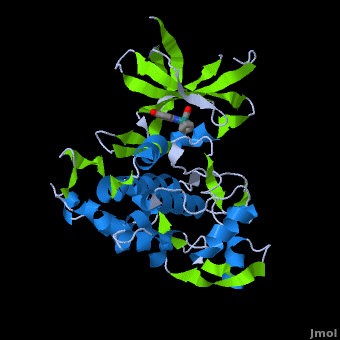Serine/threonine protein kinase
From Proteopedia
(Difference between revisions)
| Line 14: | Line 14: | ||
* '''c-Raf''' is part of the MAPK pathway. c-Raf domains include the kinase domain - residues 323-618, cysteine-rich domain – residues 136-187 and Ras-binding domain - residues 51-132. Mutations of c-Raf are possible causes of Noonan syndrome<ref>PMID:23737487</ref>. For details on '''c-Raf''' see [[Molecular Playground/C-Raf]]. | * '''c-Raf''' is part of the MAPK pathway. c-Raf domains include the kinase domain - residues 323-618, cysteine-rich domain – residues 136-187 and Ras-binding domain - residues 51-132. Mutations of c-Raf are possible causes of Noonan syndrome<ref>PMID:23737487</ref>. For details on '''c-Raf''' see [[Molecular Playground/C-Raf]]. | ||
| - | * '''mTOR''' (mammalian target of rapamycin) integrates the input from insulin, growth factors and amino acids. Rapamyacin inhibits mTOR by association with FKBP12. | + | * '''mTOR''' (mammalian target of rapamycin) integrates the input from insulin, growth factors and amino acids. Rapamyacin inhibits mTOR by association with FKBP12<ref>PMID:22500797</ref>. |
| - | * '''Gcn2''' (Generl Control Nonderepressible 2) senses amino acid deficiency by binding to uncharged tRNA. | + | * '''Gcn2''' (Generl Control Nonderepressible 2) senses amino acid deficiency by binding to uncharged tRNA<ref>PMID:26982722</ref>. |
For details on '''Snf1-related kinase''' see <br /> | For details on '''Snf1-related kinase''' see <br /> | ||
Revision as of 08:53, 25 August 2016
| |||||||||||
3D structures of serine/threonine protein kinase
Updated on 25-August-2016
References
- ↑ Bartek J, Lukas J. Chk1 and Chk2 kinases in checkpoint control and cancer. Cancer Cell. 2003 May;3(5):421-9. PMID:12781359
- ↑ Ducat D, Zheng Y. Aurora kinases in spindle assembly and chromosome segregation. Exp Cell Res. 2004 Nov 15;301(1):60-7. PMID:15501446 doi:http://dx.doi.org/10.1016/j.yexcr.2004.08.016
- ↑ Takai N, Hamanaka R, Yoshimatsu J, Miyakawa I. Polo-like kinases (Plks) and cancer. Oncogene. 2005 Jan 10;24(2):287-91. PMID:15640844 doi:http://dx.doi.org/10.1038/sj.onc.1208272
- ↑ Dummler B, Ohshiro K, Kumar R, Field J. Pak protein kinases and their role in cancer. Cancer Metastasis Rev. 2009 Jun;28(1-2):51-63. doi: 10.1007/s10555-008-9168-1. PMID:19165420 doi:http://dx.doi.org/10.1007/s10555-008-9168-1
- ↑ Forde JE, Dale TC. Glycogen synthase kinase 3: a key regulator of cellular fate. Cell Mol Life Sci. 2007 Aug;64(15):1930-44. PMID:17530463 doi:http://dx.doi.org/10.1007/s00018-007-7045-7
- ↑ Brose MS, Volpe P, Feldman M, Kumar M, Rishi I, Gerrero R, Einhorn E, Herlyn M, Minna J, Nicholson A, Roth JA, Albelda SM, Davies H, Cox C, Brignell G, Stephens P, Futreal PA, Wooster R, Stratton MR, Weber BL. BRAF and RAS mutations in human lung cancer and melanoma. Cancer Res. 2002 Dec 1;62(23):6997-7000. PMID:12460918
- ↑ Antony R, Emery CM, Sawyer AM, Garraway LA. C-RAF mutations confer resistance to RAF inhibitors. Cancer Res. 2013 Aug 1;73(15):4840-51. doi: 10.1158/0008-5472.CAN-12-4089. Epub, 2013 Jun 4. PMID:23737487 doi:http://dx.doi.org/10.1158/0008-5472.CAN-12-4089
- ↑ Laplante M, Sabatini DM. mTOR signaling in growth control and disease. Cell. 2012 Apr 13;149(2):274-93. doi: 10.1016/j.cell.2012.03.017. PMID:22500797 doi:http://dx.doi.org/10.1016/j.cell.2012.03.017
- ↑ Ravindran R, Loebbermann J, Nakaya HI, Khan N, Ma H, Gama L, Machiah DK, Lawson B, Hakimpour P, Wang YC, Li S, Sharma P, Kaufman RJ, Martinez J, Pulendran B. The amino acid sensor GCN2 controls gut inflammation by inhibiting inflammasome activation. Nature. 2016 Mar 24;531(7595):523-7. doi: 10.1038/nature17186. Epub 2016 Mar 16. PMID:26982722 doi:http://dx.doi.org/10.1038/nature17186
- ↑ Atilla-Gokcumen GE, Di Costanzo L, Meggers E. Structure of anticancer ruthenium half-sandwich complex bound to glycogen synthase kinase 3beta. J Biol Inorg Chem. 2010 Sep 7. PMID:20821241 doi:10.1007/s00775-010-0699-x

